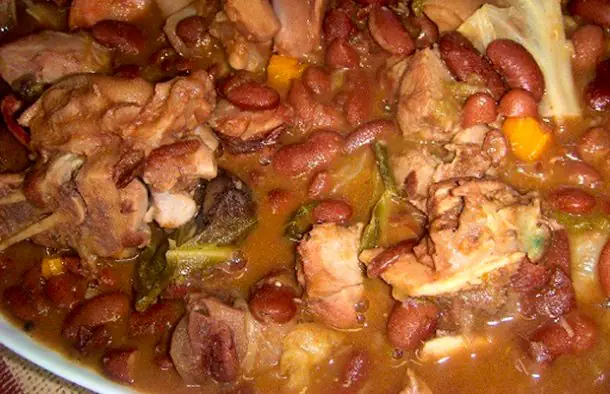Posted on Tuesday, November 27, 2018 in
Soup Recipes
Savory Portuguese Transmontana Bean Stew Recipe
This savory Portuguese transmontana bean stew recipe (feijoada transmontana), originated in the Northern region of Portugal and has been an integral dish of Portuguese gastronomy ever since.
| Preparation time | 30 min |
| Cooking Time | 1 h 30 min |
| Ready In | 2 h |
| Level of Difficulty | Easy |
| Servings | 6 |
Ingredients
2 lbs of baby back ribs2 lbs of chouriço sausage1 lb of blood sausage “morcella” (This is optional)1 lb of pork belly1 cabbage, chopped2 carrots, sliced2 onions, minced4 garlic cloves, chopped1 tablespoon of butter1/4 cup of olive oil2 bay leaves1 teaspoon of sweet paprika1 teaspoon of cumin powder2 32oz cans of cooked kidney beans1/2 cup of crushed tomatoes2 lbs of pork hocks, knuckles or earsSalt (to taste)Pepper (to taste)
Get Portuguese ingredients 
Preparation
- The night before cooking, coat the ribs with salt, wash the pig parts in cold water, salt them, and store in fridge overnight to absorb the salt.
- The next day, cook the pig parts in a large saucepan with 2 cups of water until they are soft and tender and set aside one cup of the broth.
- Now in a large saucepan cook the onions, garlic cloves, and bay leaf in the olive oil for about 5 minutes.
- Add the ribs, pork belly, paprika and let them cook for about 5 minutes over medium heat.
- Add the 1 cup of the broth you set aside earlier from cooking the pig parts and let the ribs cook for another 20 minutes, stirring occasionally.
- Add the rest of the meats, chopped cabbage, carrots, crushed tomatoes, and butter.
- Stir gently and let them cook over medium heat for about 20 minutes.
- Add the kidney beans and blood sausage, and cook for another 15 minutes.
- Check if the meats are tender and done, let it simmer on low heat for a few more minutes.
- Once done, season with salt and pepper (to taste) and serve while hot.
Recipe & Photo Credit: easyportugueserecipes.com
Adapted from a recipe by: Maria Dias, PortugueseDiner.com
Recommended Recipes
Delicious Portuguese Favas with Chouriço Recipe
This delicious Portuguese favas with chouriço recipe (receita de favas com chouriço), is easy to make and makes a delicious family meal.
| Level of Difficulty | Easy |
| Servings | 6 |
Portuguese Creamy and Flavorful Mussel Soup Recipe
This Portuguese creamy and flavorful mussel soup (sopa de mexilhão cremosa), is delicious and full of flavor, it is ideal for special occasions.
| Level of Difficulty | Easy |
| Servings | 4 |
Paula's Easy Portuguese Green Pea Stew Recipe
Paula's easy Portuguese green pea stew recipe (receita de ervilhas guisadas), a quick, delicious and great meal for four.
| Level of Difficulty | Easy |
| Servings | 4 |
Comments
There are no comments for this recipe.



